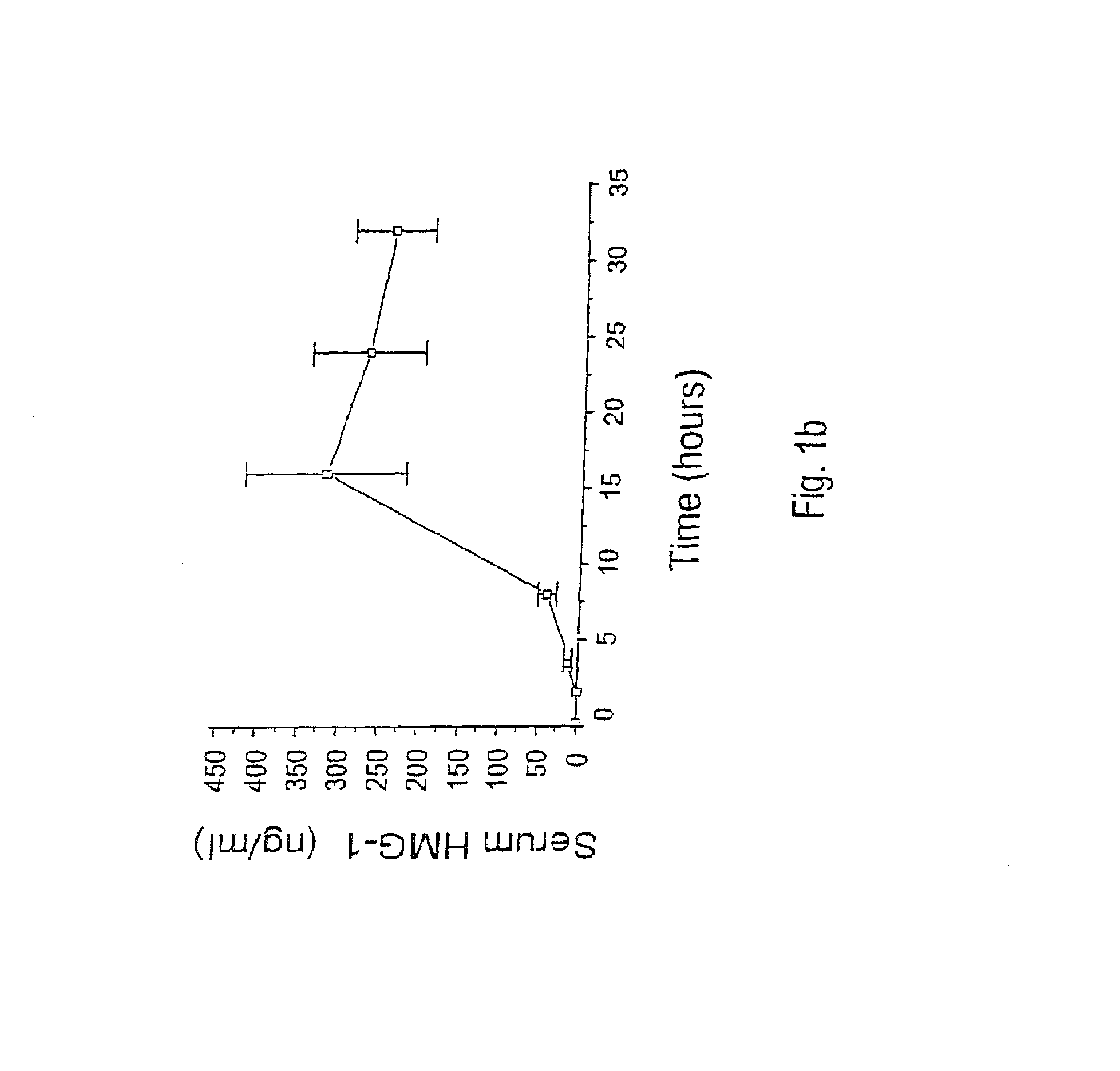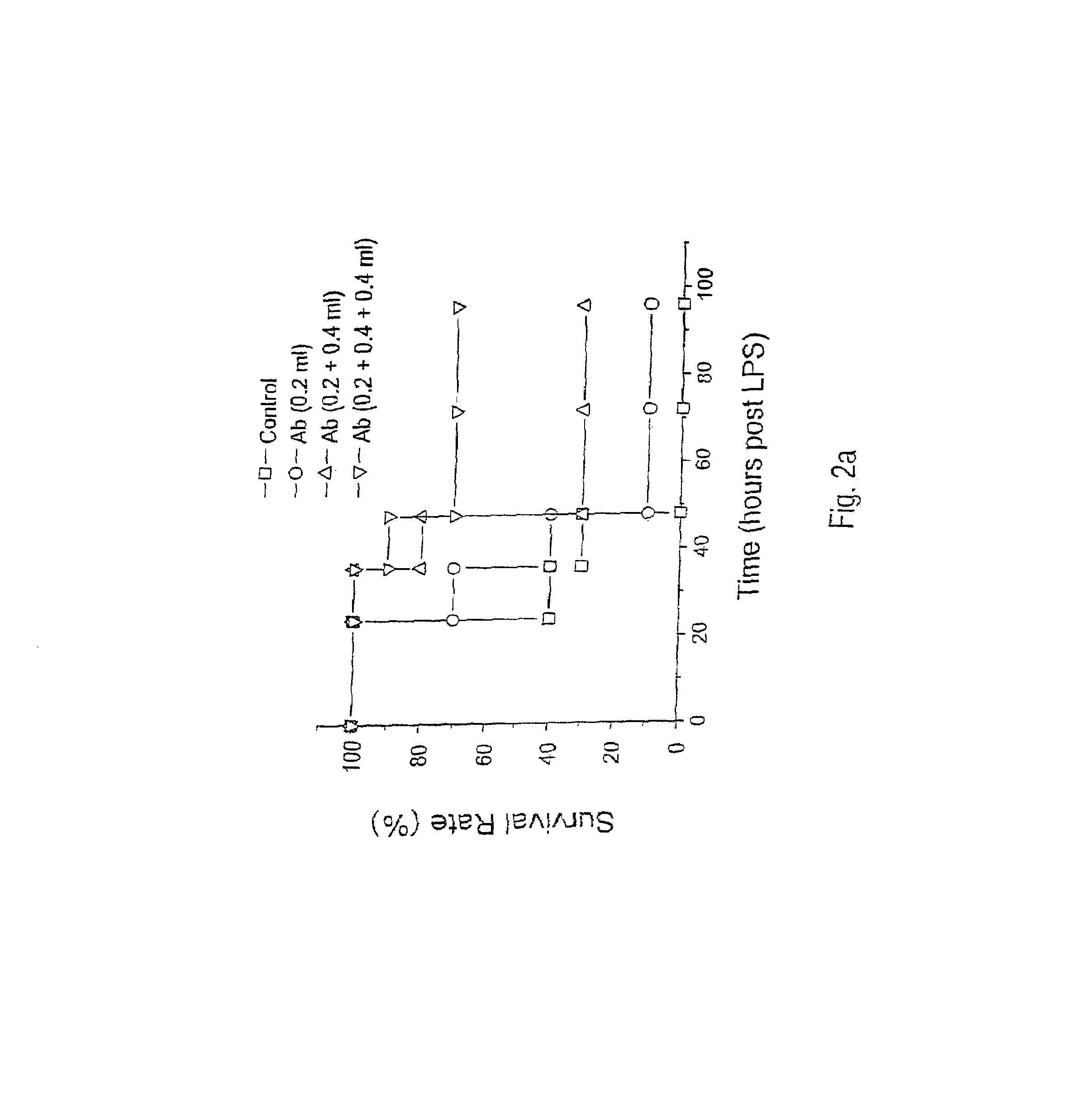Antagonists of HMG1 for treating inflammatory conditions
a technology of hmg1 and anti-inflammatory conditions, which is applied in the direction of antibody medical ingredients, peptide/protein ingredients, depsipeptides, etc., can solve the problems of sepsis being the most frequent cause of mortality in hospitalized patients, sepsis is an often fatal clinical syndrome that develops, and the use of inhibiting drugs is not easy to achiev
- Summary
- Abstract
- Description
- Claims
- Application Information
AI Technical Summary
Benefits of technology
Problems solved by technology
Method used
Image
Examples
example 1
Identification of HMG1 as a “Late” Mediator of Endotoxemia
[0142]This example provides the results of an experiment to identify and isolate later released macrophage-derived factors that play a role in sepsis and in related conditions typified by inflammatory cytokine activity. The experiment reported in this example examined murine macrophage RAW 264.7 cell-conditioned media after stimulation of the cultures with TNF. Murine macrophage RAW 264.7 cells were obtained from American Type Culture Collections (ATCC, Rockville, Md., USA), and proliferated in culture under DMEM supplemented with 10% fetal bovine serum and 1% glutamine. When confluency reached 70–80%, the medium was replaced by serum-free OPTI-MEM I medium and cultures were stimulated with pro-inflammatory cytokines (e.g., TNFα or IL-1) or bacterial endotoxin (LPS).
[0143]The proteins released from the above stimulated macrophage cultures were surveyed. Specifically, at different time points, cells and cell-conditioned media ...
example 2
Cellular Sources of HMG1
[0146]This example shows which cell sources are capable of releasing HMG1 in response to TNF, IL-1 and / or LPS. Cells studied include GH3 pituicytes, murine macrophage RAW 264.7 cells, human primary peripheral blood mononuclear cells (huPBMCs), human primary T cells, rat adrenal PC-12 cells, and rat primary kidney cells (Table 1). The rat pituitary GH3 cell line was obtained from American Type Culture Collection (ATCC, Rockville, Md., USA), and cultured in DEME supplemented with 10% fetal bovine serum and 1% glutamine. Human PBMCs and T cells were freshly isolated from whole blood of healthy donors and cultured in RPMI 1640 supplemented with 10% human serum as previously described (Zhang et al., J. Exp. Med. 185:1759–1768, 1997). When confluency reached 70–80%, the medium was replaced by serum-free OPTI-MEM I medium and cultures stimulated with proinflammatory cytokines (e.g., TNFα or IL-1) or bacterial endotoxin-(LPS).
[0147]Although human T cell, rat adrenal ...
example 3
Recombinant HMG1 Administration, In Vitro and In Vivo
[0151]This example details procedures to produce HMG1 by well-known recombinant DNA technologies. The HMG1 open reading frame was amplified by PCR and subcloned into an expression vector (pCAL-n). Briefly, the 648-bp open reading frame of HMG1 cDNA was PCR amplified (94° C. 1′, 56° C. 2′, 72° C. 45″, 30 cycles) from 5 ng Rat Brain Quick-Clone cDNA (Catalog #7150-1, Clontech, Palo Alto, Calif., USA) using primers containing the following sequences, 5′-CCC GCG GAT CCA TCG AGG GAA GGA TGG GCA AAG GAG ATC CTA-3′ [SEQ ID NO. 2], and 5′-CCC GCA AGC TTA TTC ATC ATC ATC ATC TTC T-3′ [SEQ ID NO. 3]. The 680 bp PCR product (4 μg) was digested with Barn HI and Hind III, and cloned into the Bam HI / Hind III cloning sites of the pCAL-n vector (Stratagene, La Jolla, Calif., USA). The recombinant plasmid was transformed into E. coli BL21(DE3)pLysS (Novagen, Madison, Wis., USA), and positive clones were screened and confirmed by DNA sequencing on ...
PUM
| Property | Measurement | Unit |
|---|---|---|
| body weight | aaaaa | aaaaa |
| temperature | aaaaa | aaaaa |
| concentration | aaaaa | aaaaa |
Abstract
Description
Claims
Application Information
 Login to View More
Login to View More - R&D
- Intellectual Property
- Life Sciences
- Materials
- Tech Scout
- Unparalleled Data Quality
- Higher Quality Content
- 60% Fewer Hallucinations
Browse by: Latest US Patents, China's latest patents, Technical Efficacy Thesaurus, Application Domain, Technology Topic, Popular Technical Reports.
© 2025 PatSnap. All rights reserved.Legal|Privacy policy|Modern Slavery Act Transparency Statement|Sitemap|About US| Contact US: help@patsnap.com



